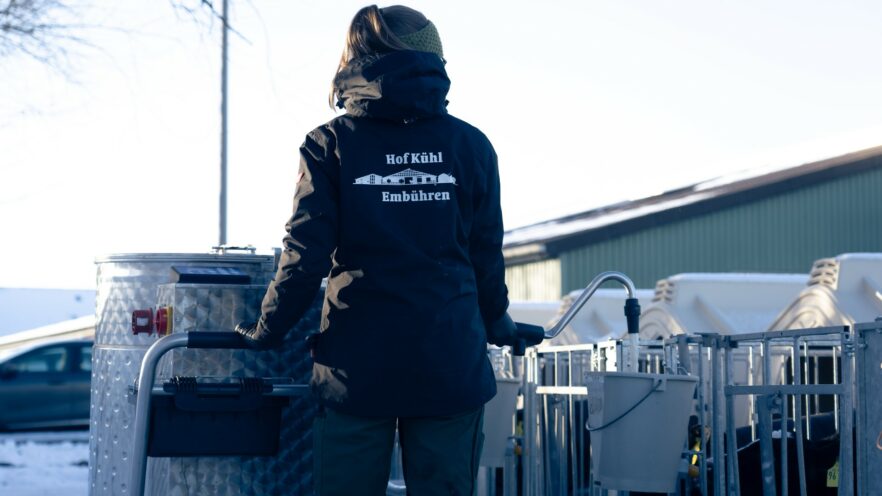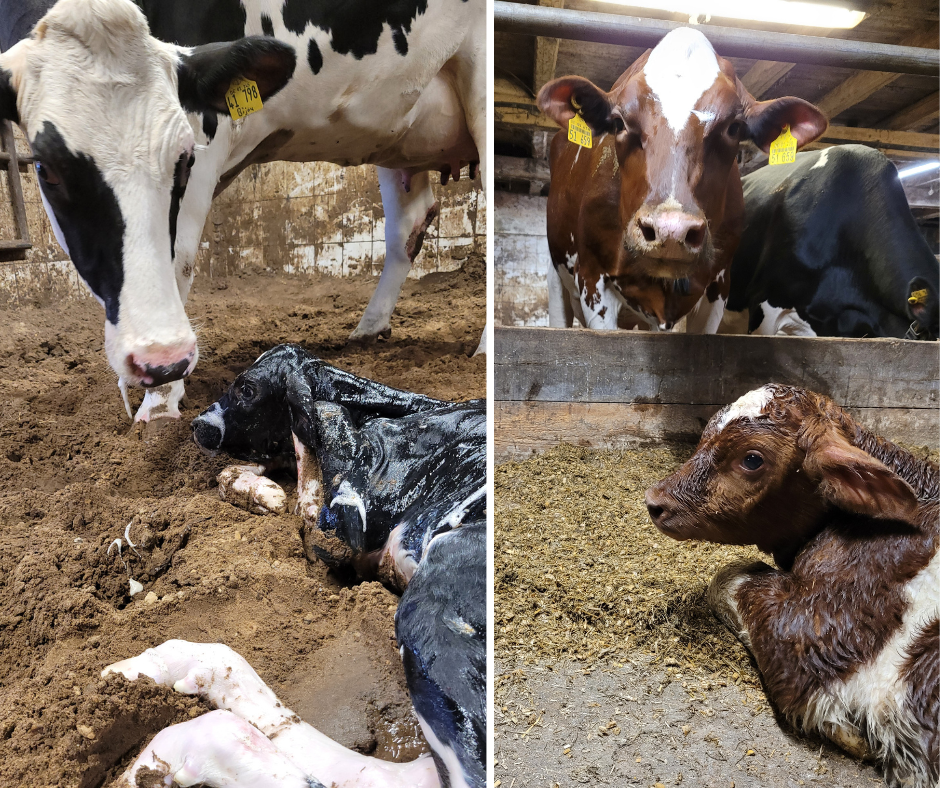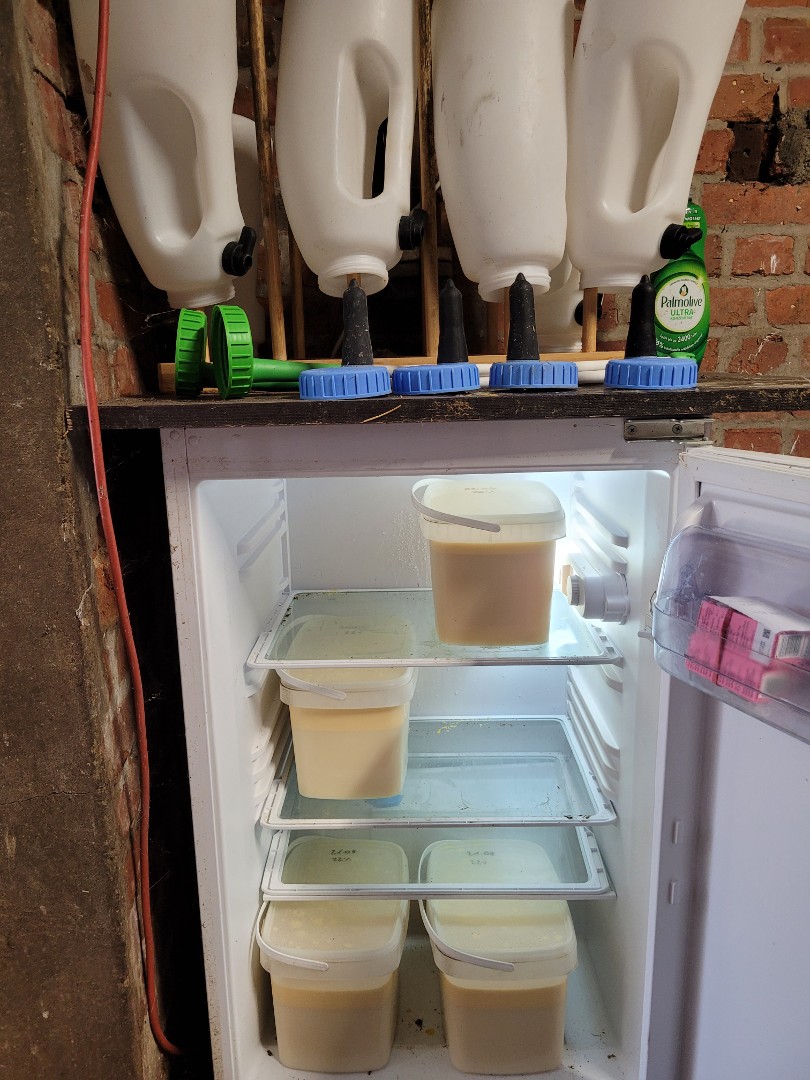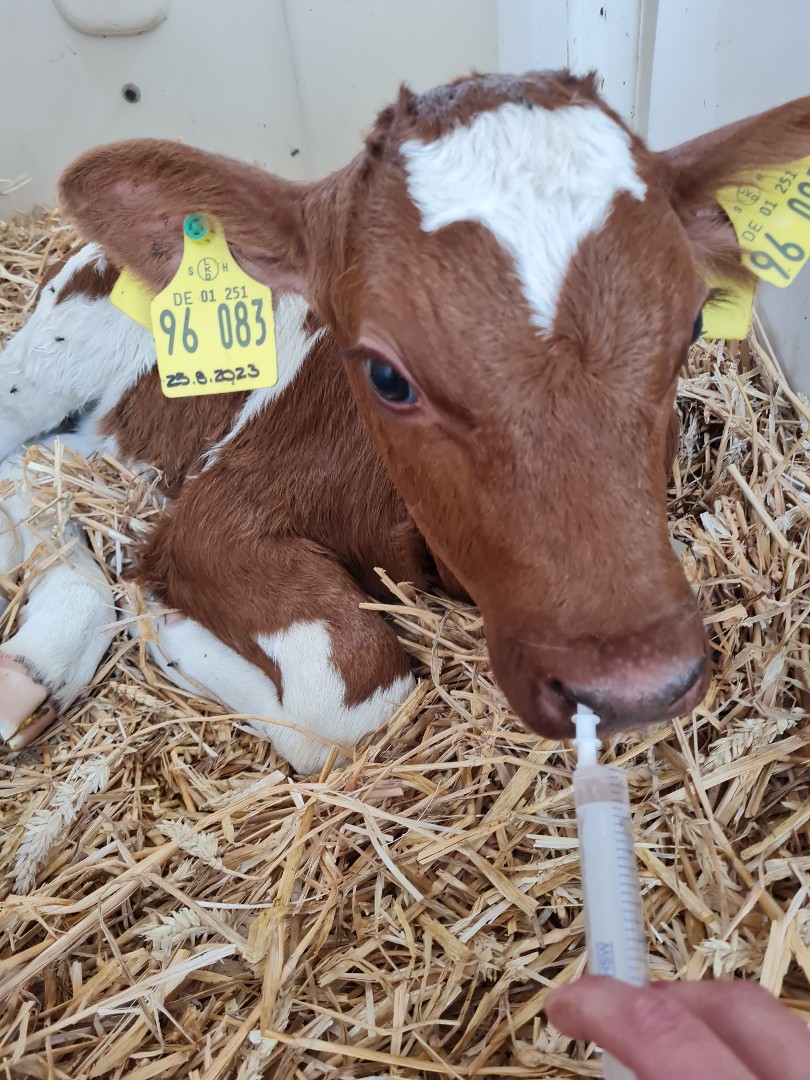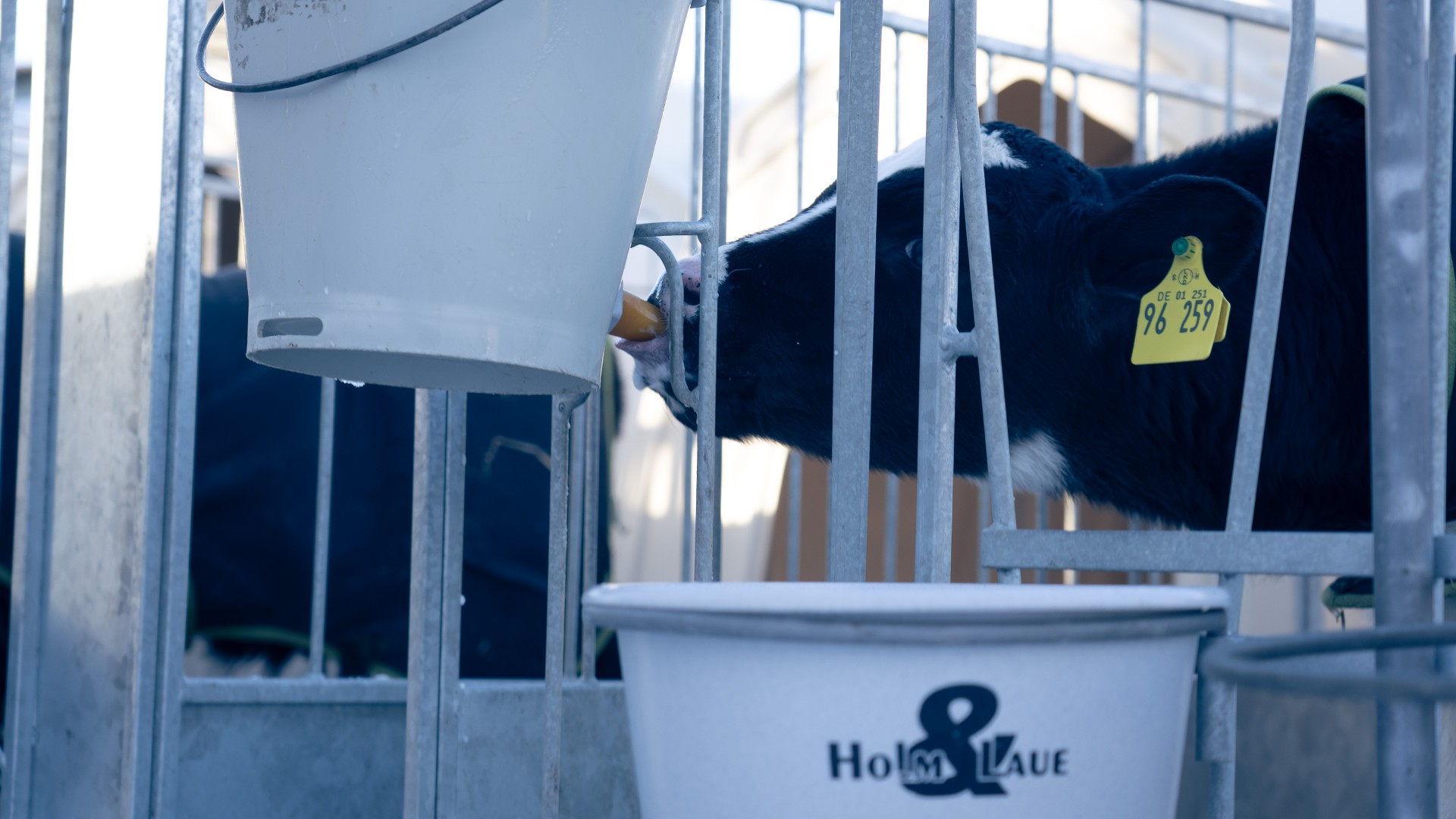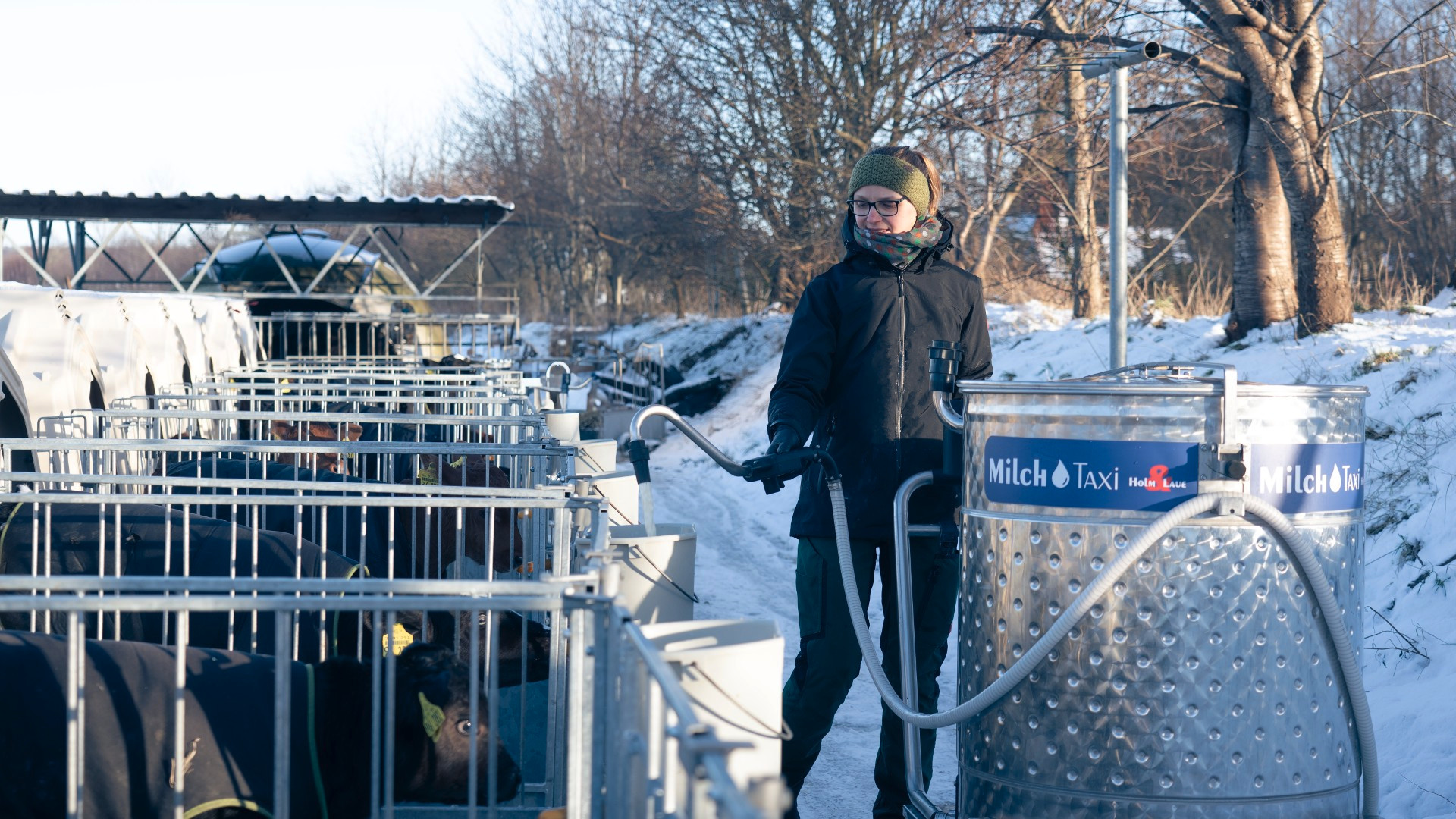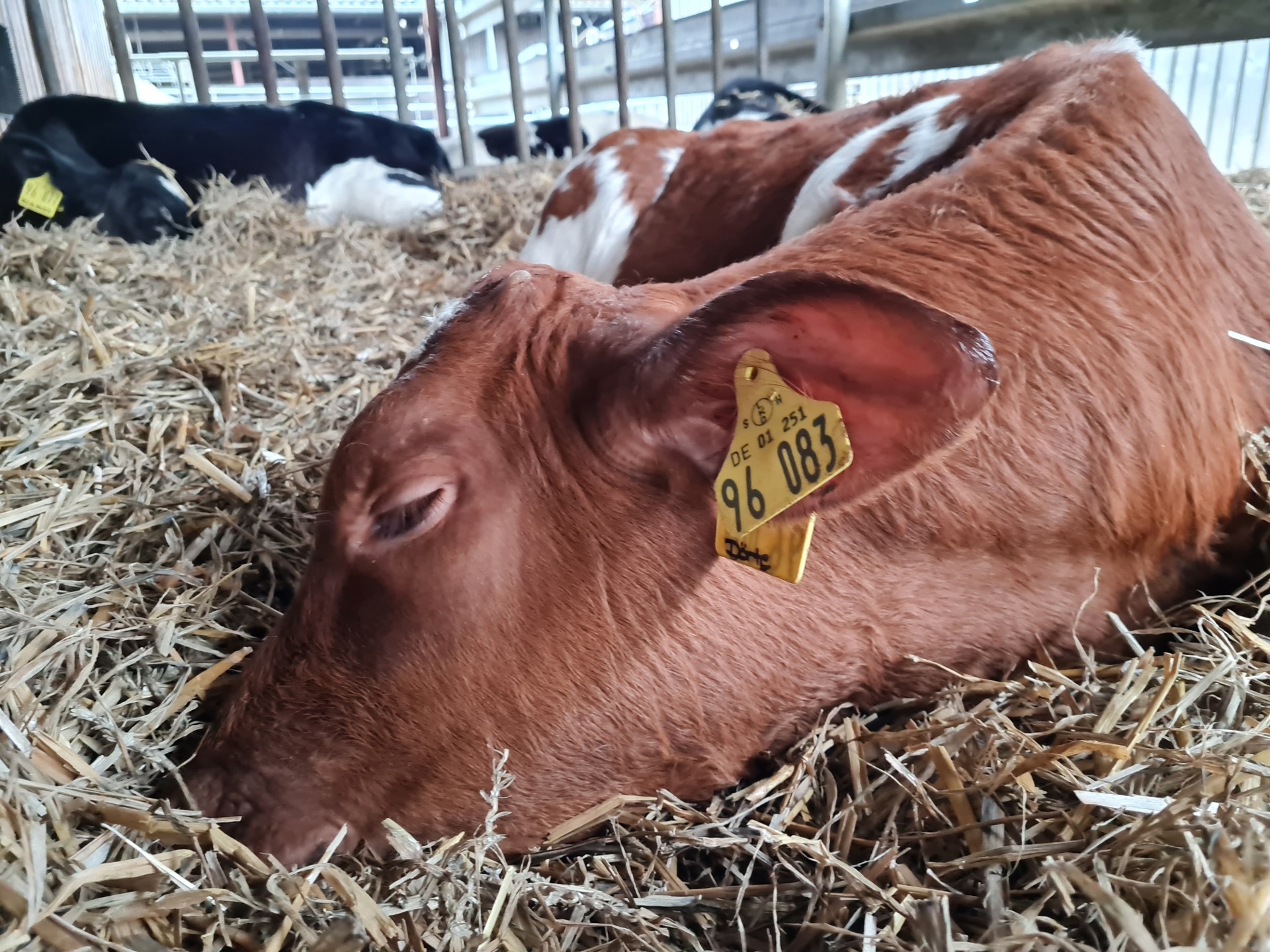A great start in life for Disney and Dörte
12. April 2024 — Immunisation, Calf Feeding, Calf management — #Work management #Colostrum #Calving assistance #Calf Health #MilkTaxi #Pasteurising #Whole milkBetween 400 and 500 calves are born every year on Henning Kühl's dairy farm in Embühren, Schleswig-Holstein, Germany. Two of these calves are Disney and Dörte, who were born last autumn.
This article is about
-
Sand in the calving pen
-
Always sufficient colostrum available
-
Standardised work instructions govern initial care
-
High immunity thanks to a clear vaccination strategy
-
Milk ad libitum, fresh water and muesli are a matter of course
-
Bedding, where necessary also with a "cosy factor"
-
Electrolyte fluids for diarrhoea
-
Housing in groups from 28 days
-
Dehorning practice
The farm manages 380 ha of land and milks approx. 400 cows with an annual output of 12,000 kg milk/cow. Henning Kühl employs 20 people, one of whom is Finja Früchtenicht. Together with her colleagues, she is responsible for raising the calves on the farm. The rearing expert has taken the trouble to document the lives of Disney and Dörte for us, from birth to weaning, providing us with a general insight into the processes involved in rearing calves on the Kühl farm.
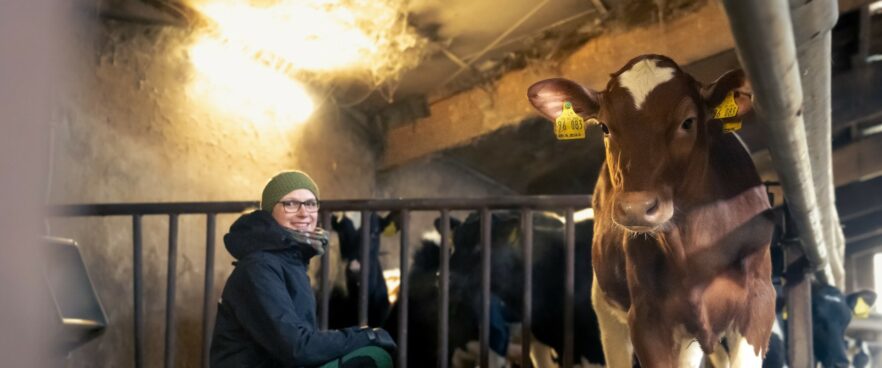
Sand in the calving pen
Cows and heifers are moved to the calving pen once signs of active calving become apparent. The calving pens are strewn with sand. In contrast to fresh straw bedding, the cows do not slip on a layer of sand, as older cows are somewhat unsteady on their feet, especially after a (difficult) calving.
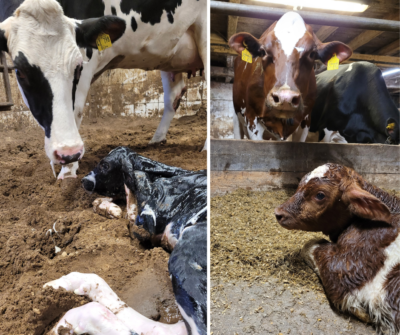
With proper care, the sand is odourless, has a low germ count, and flies are not a problem. The only disadvantage is that the calves are "breaded" at birth.
Disney was born as a Black Pied calf on 24 August 2023. Dörte, a Red Pied calf, was born one day later. Like most calvings on the Kühl farm, the births of these two also proceeded without any issues. However, assistance is always at hand on the farm should it be required.
Always sufficient colostrum available
Sufficient colostrum is available owing to the many calvings each week. The Brix value is determined using a refractometer after milking. The target value for Finja is at least 22 %. Anything below this level is not categorised as colostrum. The higher the value, the better.
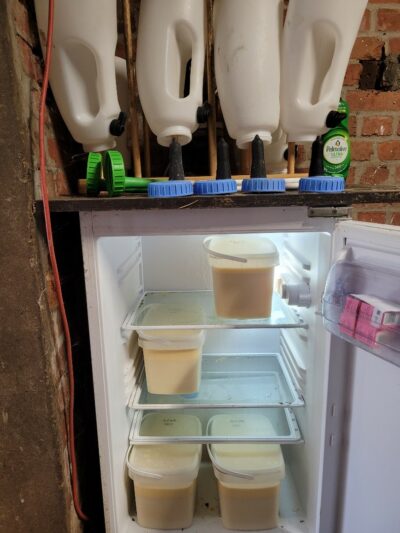
The colostrum is placed in individual containers labelled with the date and Brix value and stored in a refrigerator next to the calving pen. Sufficient clean feeding bottles and the appropriate caps are always available. All accessories are cleaned again after use.
4 litres of colostrum are heated to feeding temperature using an immersion heater before being transferred to a feeding bottle. Calves that do not yet wish to suckle voluntarily straight after calving are given the colostrum. This is particularly the case after difficult births.
Surplus colostrum or colostrum of lower quality is frozen and sold to a manufacturer of colostrum products.
Standardised work instructions govern initial care
All work steps are precisely documented on the Kühl farm using standardised work instructions. All tasks on the farm are illustrated with pictures. This means that Finja's colleagues also know what needs to be done and can monitor their own work. This of course not only applies to the subsequent steps in the initial care of calves after birth.
Disney and Dörte's navels were disinfected with blue spray after they were born. Newborn calves are placed in a heated box equipped with three heat lamps to help them dry off. As soon as they are thoroughly dry, they are placed in a freshly bedded single igloo.
High immunity thanks to a clear vaccination strategy
Disney and Dörte receive their ear tags in the first few days of their lives. The ear punch samples obtained are sent to a laboratory for testing for the BVD virus.
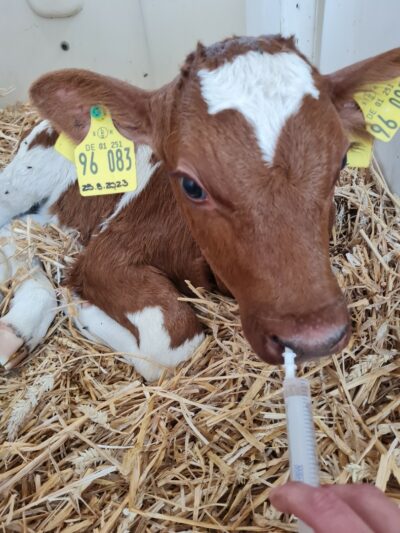
Dry cows and heifers are vaccinated against rotavirus, coronavirus and E-coli. Calves are thus already well immunised through the colostrum. In addition, all female calves on the farm are vaccinated intranasally twice against bovine respiratory syncytial virus (BRSV) and bovine parainfluenza 3 virus (PI3V) – the first time a few days after birth, the second time shortly before weaning. This lays the foundation for healthy calves. Calf losses in the first 14 days are between 3 and 5 %. This also includes all losses incurred during birth. Finja is therefore delighted with the results she has achieved with her team. Nevertheless, they are already working on new measures to further improve these numbers.
Milk ad libitum, fresh water and muesli are a matter of course
The calves receive fresh, acidified and fortified whole milk ad libitum via a teat bucket twice a day from their very first day.
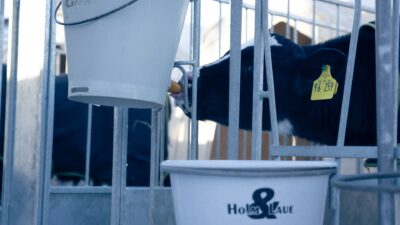
What's more, like all calves, Disney and Dörte have access to fresh water from the first day of their lives. Calves consume more water in addition to the ad libitum feed, especially on warm days or when initial symptoms of an illness appear.
They are already being provided with fresh muesli every day. The calves' rumination activity increases as they grow older. In addition to muesli, they are also given hay from the 8th week of life and later silage.
Feeding plan on the Kühl farm
| Week of life | Amount in litres | |
|---|---|---|
| 1 - 4 | 2 x 8 l | Cereal |
| 5 - 8 | 2 x 4 l | Cereal |
| 9 - 10 | 2 x 3 l | Muesli, hay |
| 11 | 2 x 2 l | Muesli, hay, silage |
| 12 | 2 x 1 l | Muesli, hay, silage |
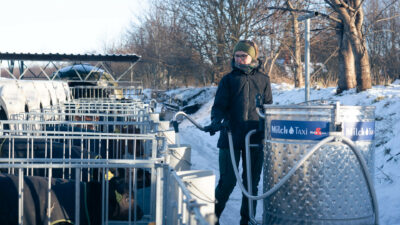
Finja only switches from the ad libitum feed in winter when there is a risk of frost. She then turns to a warm rationed feed (2 x 4 litres of milk). However, the calves consume large quantities in this case too, which ensures that their needs are well met.
The amount of milk is reduced in line with the feeding schedule. Disney and Dörte were fully weaned by the time they reached the age of 13 weeks.
Bedding, where necessary also with a "cosy factor"
A nesting score is calculated every day and the calves are provided with fresh straw. Of course, a distinction is made between dry, warm weather and continuous rain when it comes to providing the bedding. As the igloos are in the open, bedding is only used inside. In rainy weather, the calves bring a lot of moisture into the igloo, so bedding needs to be provided on a daily basis. It would, of course, also be ideal to bring the individual igloos together under one roof, but this is currently not possible on the farm.
In winter there is an extra portion of straw to add a "cosy factor". All calves wear blankets in the colder months of the year, including the bulls. Finja doesn't make any distinction.
Electrolyte fluids for diarrhoea
In the event of diarrhoea, affected calves are given an electrolyte solution in addition to the ad libitum feed and water. This ensures that the calves consume sufficient fluids and energy and that the associated fluid loss is compensated.
Housing in groups from 28 days
Disney and Dörte are transferred to small groups at the age of 28 days. Various types of housing are available on the farm for this purpose.
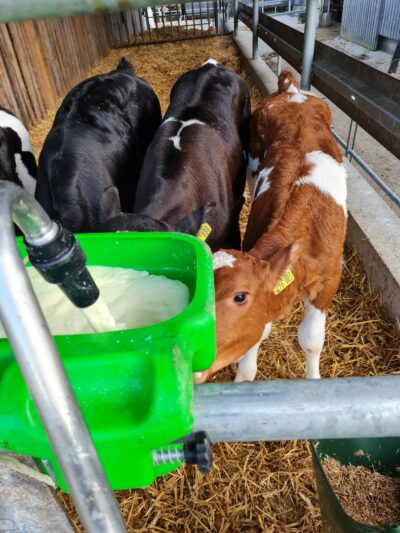
There are two Igloo Verandas and two self-built shelters. Disney and Dörte are accommodated in a group of 5 in one of the shelters, where the calves are given milk via a multi-feeder. The small groups are subsequently re-housed to form a larger group in a large igloo in a calf barn. It provides a maximum of 12 positions for teat buckets.
Water and muesli continue to be made freely available. A number of different calf toys (e.g. hay ball, chew ball, scratching mats, brush) provide entertainment in the group pens.
Dehorning practice
The calves are dehorned when they are between 6 and 8 weeks old. They are given a painkiller half an hour before dehorning and are sedated for the actual dehorning. The sclerosed horn bases are subsequently treated with blue spray.
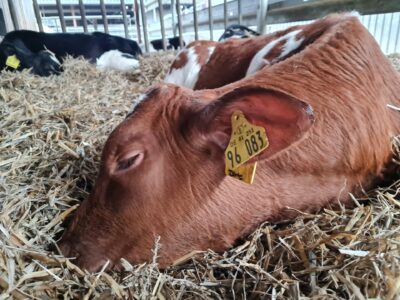
However, Finja always pays particular attention to the general conditions. Dehorning is rescheduled if there are special events such as bad weather, rehousing or other stress factors for the calves. Finja's guiding principle is: only one "event" at any one time.
This step in the calf rearing process is not required for genetically hornless calves such as Disney.
Disney and Dörte have developed really well under the care of Finja and her team. We are keen to see how they start lactation in 2 years' time and will follow their progress with interest.
Thank you very much for the insights into your calf rearing methods, Finja!
